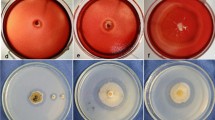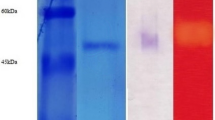Abstract
Paenibacillus species isolated from a variety of natural sources have shown to be important glycoside hydrolases producers. These enzymes play a key role in bio-refining applications, as they are central biocatalysts for the processing of different types of polymers from vegetal biomass. Xylanase production by three native isolates belonging to the genus Paenibacillus was approached by utilizing mineral-based medium and agricultural by-products as a convenient source to produce biocatalysts suitable for their degradation. While varieties of alkali pretreated sugarcane bagasse were useful substrates for the strains from Paenibacillus genus evaluated, raw sugarcane bagasse was the most effective substrate for endoxylanase production by Paenibacillus sp. AR247. This strain was then selected to further improvement of its enzyme production by means of a two-step statistical approach. It was determined that the carbon source, provided as an inexpensive agro-waste, as well as phosphate and magnesium were the culture media components that most influenced the enzyme production, which was improved three times compared to the screening results.







Similar content being viewed by others
References
Breccia JD, Castro GR, Siñeriz F (1995) Screening of xylanolytic bacteria using a colour plate method. J Appl Bacteriol 78:469–472
Camassola M, Dillon AJ (2014) Effect of different pretreatment of sugar cane bagasse on cellulase and xylanases production by the mutant Penicillium echinulatum 9A02S1 grown in submerged culture. Biomed Res Int 2014:720740
Carvalho AF, Oliva-Neto P, Zaghetto de Almeida P, Bueno da Silva J, Escaramboni B, Pastore GM (2015) Screening of xylanolytic Aspergillus fumigatus for prebiotic xylooligosaccharide production using bagasse. Food Technol Biotechnol 53(4):428–435
Collins T, Gerday C, Feller G (2005) Xylanases, xylanase families and extremophilic xylanases. FEMS Microbiol Rev 29(1):3–23
Cui F, Zhao L (2012) Optimization of xylanase production from Penicillium sp.WX-Z1 by a two-step statistical strategy: Plackett-Burman and box-Behnken experimental design. Int J Mol Sci 13(8):10630–10646
da Silva DP, Rodrigues GN, Zubieta MP, Ramoni J, Codima CA, Lima DJ, Farinas CS, da Cruz Pradella JG, Seiboth B (2017) The relation between xyr1 overexpression in Trichoderma harzianum and sugarcane bagasse saccharification performance. J Biotechnol 246:24–32
Dhar H, Kasana RC, Dutt S, Gulati A (2015) Cloning and expression of low temperature active endoglucanase EG5C from Paenibacillus sp. IHB B 3084. Int J Biol Macromol 81:259–266
Dheeran P, Nandhagopal N, Kumar S, Jaiswal YK, Adhikari DK (2012) A novel thermostable xylanase of Paenibacillus macerans IIPSP3 isolated from the termite gut. J Ind Microbiol Biotechnol 39(6):851–860
Dsouza M, Taylor MW, Ryan J, MacKenzie A, Lagutin K, Anderson RF, Turner SJ, Aislabie J (2014) Paenibacillus darwinianus sp. nov., isolated from gamma-irradiated Antarctic soil. Int J Syst Evol Microbiol 64(4):1406–1411
Gao Y, Xu J, Zhang Y, Yu Q, Yuan Z, Liu Y (2013) Effects of different pretreatment methods on chemical composition of sugarcane bagasse and enzymatic hydrolysis. Bioresour Technol 144:396–400
Grady EN, MacDonald J, Liu L, Richman A, Yuan ZC (2016) Current knowledge and perspectives of Paenibacillus: a review. Microb Cell Factories 15(1):203
Ingham CJ, Ben Jacob E (2008) Swarming and complex pattern formation in Paenibacillus vortex studied by imaging and tracking cells. BMC Microbiol 8:36
Khianngam S, Akaracharanya A, Tanasupawat S, Lee KC, Lee JS (2009) Paenibacillus thailandensis sp. nov. and Paenibacillus nanensis sp. nov., xylanase-producing bacteria isolated from soil. Int J Syst Evol Microbiol 59(3):564–568
Kim OS, Cho YJ, Lee K, Yoon SH, Kim M, Na H, Park SC, Jeon YS, Lee JH, Yi H, Won S, Chun J (2012) Introducing EzTaxon-e: a prokaryotic 16S rRNA gene sequence database with phylotypes that represent uncultured species. Int J Syst Evol Microbiol 62(3):716–721
Kimura M (1980) A simple method for estimating evolutionary rate of base substitutions through comparative studies of nucleotide sequences. J Mol Evol 16(2):111–120
Ko CH, Tsai CH, Tu J, Yang BY, Hsieh DL, Jane WN, Shih TL (2011) Identification of Paenibacillus sp. 2S–6 and application of its xylanase on biobleaching. Int Biodeterior Biodegrad 65:334–339
Kurrataa’Yun Y, Meryandini A (2015) Characterization of xylanase activity produced by Paenibacillus sp. XJ18 from TNBD Jambi. Indonesia HAYATI J Biosci 22(1):20–26
Laemmli UK (1970) Cleavage of structural proteins during the assembly of the head of bacteriophage T4. Nature 227(5259):680–685
Lee SH, Lee YE (2014) Cloning and characterization of a multidomain GH10 xylanase from Paenibacillus sp. DG-22. J Microbiol Biotechnol 24(11):1525–1535
Linares-Pastén JA, Andersson M, Karlsson EN (2014) Thermostable glycoside hydrolases in biorefinery technologies. Curr Biotechnol 3(1):26–44
Manfredi AP, Perotti NI, Martínez MA (2015) Cellulose degrading bacteria isolated from industrial samples and the gut of native insects from northwest of Argentina. J Basic Microbiol 55(12):1384–1393
Manfredi AP, Pisa JH, Valdeón DH, Perotti NI, Martínez MA (2016) Synergistic effect of simple sugars and carboxymethyl cellulose on the production of a cellulolytic cocktail from Bacillus sp. AR03 and enzyme activity characterization. Appl Biochem Biotechnol 179(1):16–32
Maroušek J, Hašková S, Zeman R, Váchal J, Vaníčková R (2014) Nutrient management in processing of steam-exploded lignocellulose phytomass. Chem Eng Technol 37(11):1945–1948
Martínez MA, Delgado OD, Baigorí MD, Siñeriz F (2005) Sequence analysis, cloning and over-expression of an endoxylanase from the alkaliphilic Bacillus halodurans. Biotechnol Lett 27(8):545–550
Miller GL (1959) Use of dinitrosalicylic acid reagent for determination of reducing sugar. Anal Chem 31:426–428
Padilha IQ, Valenzuela SV, Grisi TC, Díaz P, de Araújo DA, Pastor FI (2014) A glucuronoxylan-specific xylanase from a new Paenibacillus favisporus strain isolated from tropical soil of Brazil. Int Microbiol 17(3):175–184
Pruesse E, Peplies J, Glöckner FO (2012) SINA: accurate high-throughput multiple sequence alignment of ribosomal RNA genes. Bioinformatics 28(14):1823–1829
St. John FJ, Preston JF, Pozharski E (2012) Novel structural features of xylanase A1 from Paenibacillus sp. JDR-2. J Struct Biol 180(2):303–311
Tamura K, Stecher G, Peterson D, Filipski A, Kumar S (2013) MEGA6: molecular evolutionary genetics analysis version 6.0. Mol Biol Evol 30(12):2725–2729
Teather RM, Wood PJ (1982) Use of Congo red-polysaccharide interactions in enumeration and characterization of cellulolytic bacteria from the bovine rumen. Appl Environ Microbiol 43(4):777–780
Uday US, Choudhury P, Bandopadhyay TK, Bhunia B (2016) Classification, mode of action and production strategy of xylanase and its application for biofuel production from water hyacinth. Int J Biol Macromol 82:1041–1054
Wang Z, Quan Y, Zhou F (2014) Optimization of medium composition for exopolysaccharide production by Phellinus nigricans. Carbohydr Polym 105:200–206
Zheng HC, Sun MZ, Meng LC, Pei HS, Zhang XQ, Yan Z, Zeng WH, Zhang JS, Hu JR, Lu FP, Sun JS (2014) Purification and characterization of a thermostable xylanase from Paenibacillus sp. NF1 and its application in xylooligosaccharides production. J Microbiol Biotechnol 24(4):489–496
Acknowledgments
This work was supported by the National Scientific and Technical Research Council, Argentina, project ref. PIP-284 and by the National University of Tucumán, Argentina. E. DM. and P.M.S. thank CONICET for doctoral scholarships.
Author information
Authors and Affiliations
Corresponding author
Additional information
Responsible editor: Santiago V. Luis
Electronic supplementary material
ESM 1
(DOCX 15 kb)
Rights and permissions
About this article
Cite this article
Di Marco, E., Soraire, P.M., Romero, C.M. et al. Raw sugarcane bagasse as carbon source for xylanase production by Paenibacillus species: a potential degrader of agricultural wastes. Environ Sci Pollut Res 24, 19057–19067 (2017). https://doi.org/10.1007/s11356-017-9494-3
Received:
Accepted:
Published:
Issue Date:
DOI: https://doi.org/10.1007/s11356-017-9494-3




